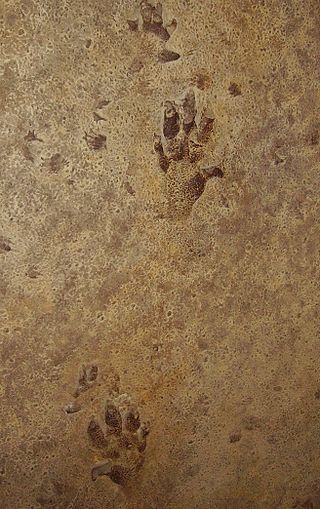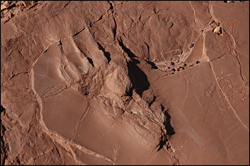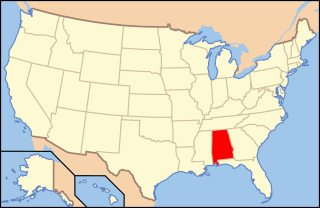Related Research Articles
The PaleozoicEra is the first of three geological eras of the Phanerozoic Eon. Beginning 538.8 million years ago (Ma), it succeeds the Neoproterozoic and ends 251.9 Ma at the start of the Mesozoic Era. The Paleozoic is subdivided into six geologic periods :

Carbon Hill is a city in Walker County, Alabama, United States. It incorporated in February 1891. At the 2010 census the population was 2,021, down from 2,071 in 2000.

A trace fossil, also known as an ichnofossil, is a fossil record of biological activity by lifeforms but not the preserved remains of the organism itself. Trace fossils contrast with body fossils, which are the fossilized remains of parts of organisms' bodies, usually altered by later chemical activity or by mineralization. The study of such trace fossils is ichnology - the work of ichnologists.

Treptichnus is the preserved burrow of an animal. As such, it is regarded as the earliest widespread complex trace fossil. Its earliest appearance, around 542 million years ago (mya), which was contemporaneous with the last of the Ediacaran biota, is used to help define the dividing line, considered geologically at 541 mya, between the Ediacaran and Cambrian periods. It is last seen in the fossil record during the Cenomanian.

A fossil track or ichnite is a fossilized footprint. This is a type of trace fossil. A fossil trackway is a sequence of fossil tracks left by a single organism. Over the years, many ichnites have been found, around the world, giving important clues about the behaviour of the animals that made them. For instance, multiple ichnites of a single species, close together, suggest 'herd' or 'pack' behaviour of that species.

Mesolimulus is an extinct genus of horseshoe crab. The best known examples are found in Solnhofen limestone near Solnhofen, Bavaria, Germany. Originally assigned to the living genus Limulus, they are related to and look virtually identical to modern horseshoe crabs. Other species assigned to Mesolimulus have been recorded spanning over 140 million years from the Middle Triassic to Late Cretaceous from England, Spain, Siberia and Morocco.

Truman Heminway Aldrich was a civil engineer, a mining company executive, and a paleontologist, and briefly served in the United States House of Representatives and as Postmaster of Birmingham. He is the sole Republican ever to represent Alabama's 9th congressional district, which existed from 1893 to 1963. His brother William F. Aldrich also represented Alabama in Congress, serving three partial terms during 1896–1901 from Alabama's 4th congressional district.

The Black Warrior Basin is a geologic sedimentary basin of western Alabama and northern Mississippi in the United States. It is named for the Black Warrior River and is developed for coal and coalbed methane production, as well as for conventional oil and natural gas production. Coalbed methane of the Black Warrior Basin has been developed and in production longer than in any other location in the United States. The coalbed methane is produced from the Pennsylvanian Pottsville Coal Interval.

The Allegheny Group, often termed the Allegheny Formation, is a Pennsylvanian-age geological unit in the Appalachian Plateau. It is a major coal-bearing unit in the eastern United States, extending through western and central Pennsylvania, western Maryland and West Virginia, and southeastern Ohio. Fossils of fishes such as Bandringa are known from the Kittaning Formation, which is part of the Allegheny Group.

Prehistoric Trackways National Monument is a national monument in the Robledo Mountains of Doña Ana County, New Mexico, United States, near the city of Las Cruces. The monument's Paleozoic Era fossils are on 5,255 acres (2,127 ha) of land administered by the Bureau of Land Management. It became the 100th active U.S. national monument when it was designated on March 30, 2009.
Micrichnus is a trace fossil ichnogenus of arthropods. It was once thought to be a trace fossil made by a vertebrate.

Paleontology in Pennsylvania refers to paleontological research occurring within or conducted by people from the U.S. state of Pennsylvania. The geologic column of Pennsylvania spans from the Precambrian to Quaternary. During the early part of the Paleozoic, Pennsylvania was submerged by a warm, shallow sea. This sea would come to be inhabited by creatures like brachiopods, bryozoans, crinoids, graptolites, and trilobites. The armored fish Palaeaspis appeared during the Silurian. By the Devonian the state was home to other kinds of fishes. On land, some of the world's oldest tetrapods left behind footprints that would later fossilize. Some of Pennsylvania's most important fossil finds were made in the state's Devonian rocks. Carboniferous Pennsylvania was a swampy environment covered by a wide variety of plants. The latter half of the period was called the Pennsylvanian in honor of the state's rich contemporary rock record. By the end of the Paleozoic the state was no longer so swampy. During the Mesozoic the state was home to dinosaurs and other kinds of reptiles, who left behind fossil footprints. Little is known about the early to mid Cenozoic of Pennsylvania, but during the Ice Age it seemed to have a tundra-like environment. Local Delaware people used to smoke mixtures of fossil bones and tobacco for good luck and to have wishes granted. By the late 1800s Pennsylvania was the site of formal scientific investigation of fossils. Around this time Hadrosaurus foulkii of neighboring New Jersey became the first mounted dinosaur skeleton exhibit at the Academy of Natural Sciences in Philadelphia. The Devonian trilobite Phacops rana is the Pennsylvania state fossil.

Paleontology in Georgia refers to paleontological research occurring within or conducted by people from the U.S. state of Georgia. During the early part of the Paleozoic, Georgia was largely covered by seawater. Although no major Paleozoic discoveries have been uncovered in Georgia, the local fossil record documents a great diversity of ancient life in the state. Inhabitants of Georgia's early Paleozoic sea included corals, stromatolites, and trilobites. During the Carboniferous local sea levels dropped and a vast complex of richly vegetated delta formed in the state. These swampy deltas were home to early tetrapods which left behind footprints that would later fossilize. Little is known of Triassic Georgia and the Jurassic is absent altogether from the state's rock record. During the Cretaceous, however, southern Georgia was covered by a sea that was home to invertebrates and fishes. On land, the tree Araucaria grew, and dinosaurs inhabited the state. Southern Georgia remained submerged by shallow seawater into the ensuing Paleogene and Neogene periods of the Cenozoic era. These seas were home to small coral reefs and a variety of other marine invertebrates. By the Pleistocene the state was mostly dry land covered in forests and grasslands home to mammoths and giant ground sloths. Local coal mining activity has a history of serendipitous Carboniferous-aged fossil discoveries. Another major event in Georgian paleontology was a 1963 discovery of Pleistocene fossils in Bartow County. Shark teeth are the Georgia state fossil.

Paleontology in Alabama refers to paleontological research occurring within or conducted by people from the U.S. state of Alabama. Pennsylvanian plant fossils are common, especially around coal mines. During the early Paleozoic, Alabama was at least partially covered by a sea that would end up being home to creatures including brachiopods, bryozoans, corals, and graptolites. During the Devonian the local seas deepened and local wildlife became scarce due to their decreasing oxygen levels.

Paleontology in Colorado refers to paleontological research occurring within or conducted by people from the U.S. state of Colorado. The geologic column of Colorado spans about one third of Earth's history. Fossils can be found almost everywhere in the state but are not evenly distributed among all the ages of the state's rocks. During the early Paleozoic, Colorado was covered by a warm shallow sea that would come to be home to creatures like brachiopods, conodonts, ostracoderms, sharks and trilobites. This sea withdrew from the state between the Silurian and early Devonian leaving a gap in the local rock record. It returned during the Carboniferous. Areas of the state not submerged were richly vegetated and inhabited by amphibians that left behind footprints that would later fossilize. During the Permian, the sea withdrew and alluvial fans and sand dunes spread across the state. Many trace fossils are known from these deposits.

Paleontology in Arizona refers to paleontological research occurring within or conducted by people from the U.S. state of Arizona. The fossil record of Arizona dates to the Precambrian. During the Precambrian, Arizona was home to a shallow sea which was home to jellyfish and stromatolite-forming bacteria. This sea was still in place during the Cambrian period of the Paleozoic era and was home to brachiopods and trilobites, but it withdrew during the Ordovician and Silurian. The sea returned during the Devonian and was home to brachiopods, corals, and fishes. Sea levels began to rise and fall during the Carboniferous, leaving most of the state a richly vegetated coastal plain during the low spells. During the Permian, Arizona was richly vegetated but was submerged by seawater late in the period.

The Abo Formation is a geologic formation in New Mexico. It contains fossils characteristic of the Cisuralian epoch of the Permian period.
This article records new taxa of trace fossils of every kind that are scheduled to be described during the year 2019, as well as other significant discoveries and events related to trace fossil paleontology that are scheduled to occur in the year 2019.
David C. Kopaska-Merkel is an American geologist, poet, and editor.
Oneonta High School is a secondary school in Oneonta, Alabama. It is the only high school in the Oneonta School District. It was founded in 1893 incorporated in 1900. Redskins are the school mascot.
References
- 1 2 Buta, Ronald J.; Kopaska-Merkel, David C. (2016). Footprints in Stone: Fossil Traces of Coal-Age Tetrapods . University of Alabama Press. ISBN 9780817389567. OCLC 942826537 . Retrieved 2023-02-21.
- ↑ Ehret, Dana J.; Kopaska-Merkel, David C.; Buta, Ronald J. (February 19, 2016). "Footprints in Stone: Fossil Traces of Coal-Age Tetrapods". The University of Alabama Press – via Project MUSE.
- ↑ "Stephen C. Minkin Paleozoic Footprint Site". Encyclopedia of Alabama.
- ↑ Rindsberg, Andrew K.; Kopaska-Merkel, David C. (2005). "Treptichnus and Arenicolites From the Steven C. Minkin Paleozoic Footprint Site (Langsettian, Alabama, USA)" (PDF). Alabama Paleontological Society Monograph. 1.
- ↑ "Field-Trip Guidebook to the Steven C. Minkin Footprint Site, Walker County, Alabama". Alabama Paleontological Society. Retrieved 2023-02-21.
- ↑ Underwood, Madison (2014-04-09). "This weekend, your family can dig for fossils in one of the world's premier fossil sites near Sumiton". Advance Local. Retrieved 2023-02-21.
- ↑ King, Olivia A.; Stimson, Matthew R.; Lucas, Spencer G. (2019-10-02). "The Ichnogenus Kouphichnium and Related Xiphosuran Traces from the Steven C. Minkin Paleozoic Footprint Site (Union Chapel Mine), Alabama, USA: Ichnotaxonomic and Paleoenvironmental Implications". Ichnos. 26 (4): 266–302. Bibcode:2019Ichno..26..266K. doi: 10.1080/10420940.2018.1561447 . ISSN 1042-0940.
- ↑ "Alabama Fossils". Alabama Public Television. 2021-05-06. Retrieved 2023-02-21.